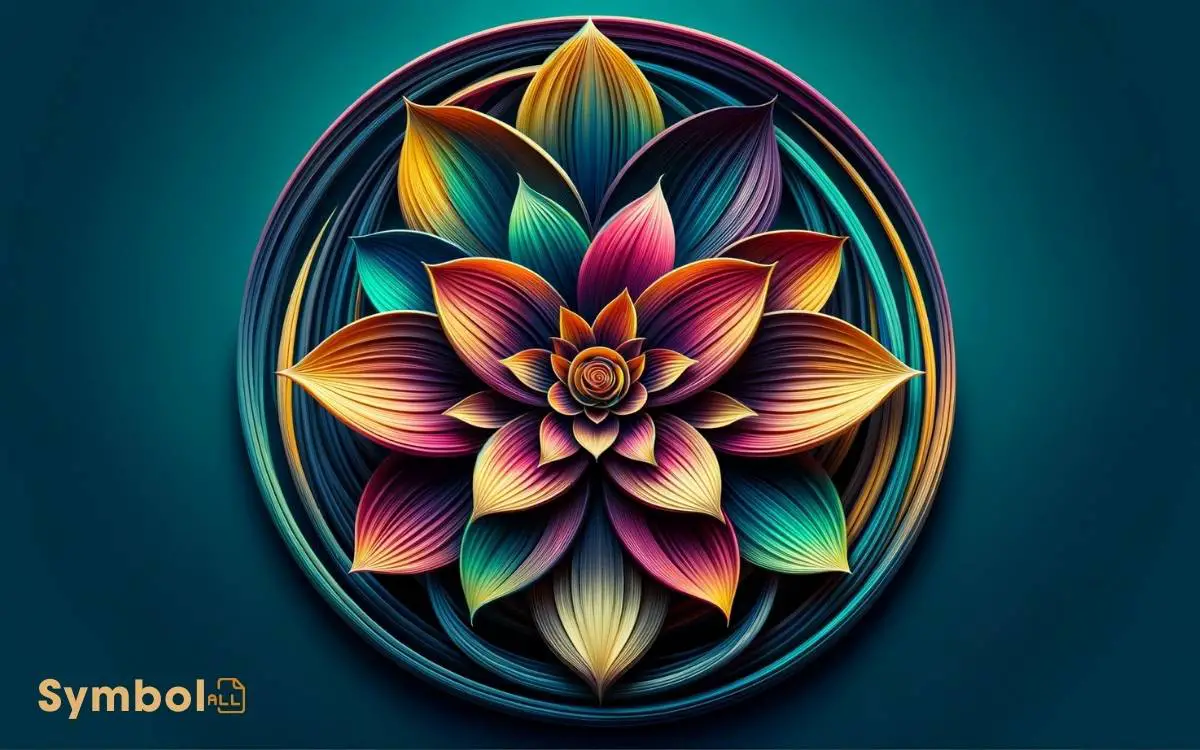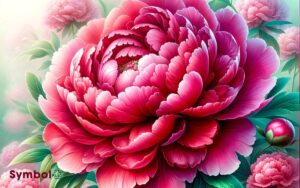What Flower Symbolizes Beauty and Strength? Lotus Flower!
You’re likely searching for a flower that embodies both beauty and strength. The Lotus Flower stands out in this regard. Its biological resilience and ability to thrive in aquatic environments underscore its strength.
Symbolically, it represents purity, enlightenment, and the capacity to rise above challenging conditions, drawing parallels to human resilience. Scientifically, its self-cleaning attribute and seed longevity are proof of its adaptability and vigor.
Culturally, the Lotus holds profound significance across Egyptian, Hindu, and Buddhist narratives, symbolizing a quest for knowledge and enlightenment. Understanding its universal reverence could offer you deeper insights into its symbolic significance.

Key Takeaways
The Lotus Flower Essence
While seemingly delicate, the lotus flower possesses a remarkable resilience and adaptability, embodying a unique essence that has fascinated botanists and symbolists alike.
Thriving in muddy waters, its ability to rise above the surface, bloom unblemished, and regulate its temperature like a warm-blooded animal showcases evolutionary marvels.
You’ll find it intriguing that the lotus’s petals have a sophisticated structure that repels mud and water, maintaining its immaculate state through a phenomenon termed the ‘lotus effect.’
This self-cleaning attribute symbolizes purity and enlightenment in various cultures. Additionally, its seed longevity, with seeds viable for centuries, underscores a profound endurance.
Analyzing its life cycle, you discern a metaphor for human resilience and the capability to remain untainted by the surrounding chaos.
Historical Significance
Throughout history, cultures worldwide have revered the lotus flower, assigning it profound symbolic meanings that explore the essence of human existence and spiritual awakening.
This reverence isn’t merely aesthetic but deeply rooted in the flower’s unique biological characteristics.
The lotus’s ability to rise from murky waters unscathed symbolizes purity and resilience amidst adversity.
Scientifically, the lotus exhibits remarkable thermoregulation, maintaining a consistent temperature despite environmental changes, a metaphor for emotional and spiritual stability.
Its seeds can remain viable for centuries, embodying the concept of immortality and the cyclic nature of life and rebirth.
These attributes haven’t only fascinated botanists but have also lent the lotus a significant historical role in representing the enduring quest for knowledge and enlightenment.
Cultural Symbolism
The lotus flower’s symbolism transcends its biological marvels, deeply embedding itself in various cultural narratives where it epitomizes beauty, strength, and spiritual enlightenment.
In ancient Egyptian culture, the lotus represented the sun’s rebirth due to its daily cycle of closing at night and blooming at dawn, symbolizing resurrection and eternal life.
Similarly, in Hinduism and Buddhism, it stands as a metaphor for awakening to the spiritual reality of life.
The lotus’s ability to emerge unscathed from murky waters offers a vivid illustration of purity and enlightenment triumphing over adversity.
This multifaceted symbolism, deeply rooted in the flower’s interaction with its environment, resonates across cultures, illustrating a universal reverence for its qualities.
It’s this rich tapestry of meanings that positions the lotus as a potent symbol of beauty and strength.
Biological Resilience
Beyond its symbolic significance, the lotus flower exhibits remarkable biological resilience, thriving in conditions that would hinder most plants.
Here’s why:
- Adaptation to Water: The lotus has evolved to flourish in muddy, aquatic environments, leveraging its waterproof leaves and stem to remain buoyant and unsoiled.
- Temperature Regulation: Remarkably, it can maintain a stable temperature, even when external conditions fluctuate, ensuring ideal enzyme activity for growth.
- Efficient Photosynthesis: Its broad leaves maximize sunlight absorption, enhancing photosynthesis and energy production, critical for survival in murky waters.
- Seed Longevity: Lotus seeds can remain viable for centuries, an extraordinary feat that underscores its unparalleled endurance and resilience.
Understanding these mechanisms reveals the lotus’s ability not just to survive but to thrive, illustrating a perfect blend of beauty and strength from a biological perspective.
Spiritual Meanings
You’ll find that flowers’ spiritual meanings often reflect their biological resilience, offering a nuanced analysis of symbolic growth interpretations.
Through examining cultural belief connections, you can uncover how societies globally have infused flowers with meanings that signify inner strength.
This exploration into spiritual symbolism reveals a complex interplay between nature and human perception, grounded in scientific and anthropological research.
Symbolic Growth Interpretations
Interpreting symbolic growth, flowers represent transformative journeys, embodying both beauty and resilience in their bloom. This examination explores the spiritual meanings, focusing on how flowers symbolize a cycle of growth and renewal.
Analyzing this from a scientific perspective:
- Germination Stage: Symbolizes potential and the inception of new ideas or phases in life.
- Growth Phase: Represents personal development and the accumulation of knowledge and experience.
- Blossoming: Reflects the attainment of beauty and strength through perseverance and resilience.
- Seed Dispersal: Suggests the sharing of wisdom and the beginning of new cycles.
Each stage in a flower’s life cycle offers a metaphor for spiritual and personal growth, emphasizing the importance of resilience and adaptation in the face of challenges.
Cultural Belief Connections
Exploring the symbolic growth of flowers further, we now examine the deep-rooted cultural beliefs and spiritual meanings attributed to them across various societies.
| Culture | Flower | Meaning |
|---|---|---|
| Japanese | Cherry Blossom | Transience of life, beauty, and renewal |
| Egyptian | Lotus | Purity, rebirth, the sun |
| Celtic | Oak Tree Blossom | Strength, endurance, and protection |
These flowers and their associated meanings are not merely decorative but are deeply entwined with the cultural and spiritual fabric of each society.
For instance, the cherry blossom’s fleeting beauty underscores the Japanese philosophical focus on impermanence and the beauty found within it.
Similarly, the lotus flower, emerging pure from murky waters, symbolizes the potential for purity and enlightenment despite adverse conditions, echoing ancient Egyptian beliefs in rebirth and the cyclical nature of life.
Inner Strength Representation
Delving into the domain of inner strength, flowers embody a myriad of spiritual meanings that reflect the resilience and fortitude of the human spirit.
To deepen your understanding, consider these points:
- Lotus Flower: Symbolizes purity and enlightenment, thriving in muddy waters, it represents the ability to rise above challenges.
- Oak Blossoms: Signify strength and stability, echoing the enduring nature of the human will.
- Gladiolus: Known for its towering beauty, it epitomizes moral integrity and the strength of character.
- Cherry Blossom: In Japanese culture, it’s a reminder of life’s fragility and the strength required to face its transience with grace.
Each flower holds a complex interaction of biochemical and ecological systems, which, in parallel, mirrors the intricate dynamics of human resilience and spiritual growth.
Artistic Inspirations
Drawing inspiration from the natural world, artists have long celebrated the flower as a symbol of beauty and strength, incorporating its imagery into a diverse range of works.
This incorporation isn’t merely aesthetic; it’s deeply rooted in the symbolic language of flora, where each petal, color, and arrangement conveys specific meanings.
Through careful analysis, you can uncover how artists use these symbols to communicate complex emotions and ideas, weaving them into the very fabric of culture.
| Flower | Symbolic Meaning |
|---|---|
| Rose | Love, valor |
| Lotus | Purity, enlightenment |
| Orchid | Beauty, strength |
The table above highlights how these flowers serve as potent symbols within art, each carrying a depth of meaning that transcends their natural beauty.
Gardening Tips
To cultivate flowers that embody both beauty and strength, you must first understand the science behind ideal soil preparation techniques, ensuring the soil’s pH and nutrient levels are meticulously balanced.
A precise watering schedule is critical, as it directly affects the plant’s cellular processes and overall health, necessitating a balance between hydration and drainage to prevent root rot.
Soil Preparation Techniques
Preparing your garden’s soil effectively requires understanding its composition and nutrient levels to create an ideal growing environment for flowers symbolizing beauty and strength.
To achieve this, follow these scientifically-backed techniques:
- Conduct a Soil Test: Determine pH levels and nutrient deficiencies to tailor your soil amendments accurately.
- Incorporate Organic Matter: Compost or manure enhances soil structure, providing essential nutrients and improving water retention.
- Adjust pH Levels: If your soil is too acidic or alkaline, use lime to raise pH or sulfur to lower it, based on your test results.
- Till the Soil: Loosen up to 12-15 inches deep to facilitate root growth and improve aeration.
These steps guarantee your soil is well-prepared, fostering a thriving garden where beauty and strength flourish.
Watering Schedule Essentials
Determining an ideal watering timetable is crucial for preserving the vitality of your garden. Both under-watering and over-watering can greatly hinder the growth of flowers symbolizing beauty and strength. Scientifically, plants exhibit varied transpiration rates.
This process involves moisture being carried through plants from roots to small pores on the underside of leaves. Here, it changes to vapor and is released into the atmosphere.
This physiological fact underscores the necessity of a tailored watering schedule that accounts for species-specific needs, environmental conditions, and soil moisture retention capabilities.
Typically, early morning watering reduces evaporation and aids in disease prevention. Additionally, employing drip irrigation systems can enhance water delivery efficiency. This method allows water to reach the roots directly, minimizing wastage.
Understanding these mechanisms allows for the best hydration levels. This promotes robust growth and the flourishing of your garden’s symbolic blooms.
Pest Control Strategies
Implementing effective pest control strategies is crucial for safeguarding the beauty and resilience of your garden’s flowers, as pests can greatly undermine plant health and growth.
Here are four scientifically proven methods to protect your blooms:
- Biological Control: Introducing natural predators, like ladybugs, to eat aphids, reduces pest populations without chemical intervention.
- Cultural Practices: Rotating crops and selecting pest-resistant plant varieties can greatly lower pest infestations.
- Chemical Control: When necessary, applying targeted pesticides—preferably organic—to affected areas can control severe infestations. Always follow the label’s instructions to minimize environmental impact.
- Physical Barriers: Netting and row covers physically prevent pests from reaching plants, offering a non-toxic method of protection.
These strategies, when applied thoughtfully, can ensure your garden remains a testament to both beauty and strength.
Varieties and Colors
Various species and hues of flowers symbolize both beauty and strength, each with unique biochemical properties and morphologies that contribute to their symbolic meanings.
Investigate further, and you’ll discover roses, often heralded for their layered petals and resilience, embodying love and courage across various colors.
Red roses, with their vibrant hue, stem from anthocyanins, powerful antioxidants, symbolizing deep passion and strength.
Meanwhile, lavender roses, containing the same anthocyanins at different concentrations, represent enchantment and uniqueness, their rarity underlining a strength in standing out.
Sunflowers, with their heliotropic behavior, showcase strength in adaptability and growth towards light, embodying positivity and robustness.
Each color variation in sunflowers, from bright yellows to deep reds, results from complex genetic variations, further emphasizing diversity and adaptability as forms of strength.
Global Perspectives
You’ll find that cultural interpretations and universal meanings of flowers vary notably across the globe. These differences stem from historical, geographical, and societal influences that shape the perception of beauty and strength in flora.
Analyzing these variances provides insight into the complex interplay between nature and cultural identity, highlighting the role of flowers as both universal symbols and culturally specific markers.
Cultural Interpretations
Across cultures, the flower symbolizing beauty and strength is interpreted through diverse lenses, reflecting unique historical, social, and environmental contexts.
Here’s how this symbolism varies globally:
- In Japan, the cherry blossom, or Sakura, represents the transient nature of life and beauty, embodying strength in its brief blooming period.
- In China, the peony stands as a symbol of prosperity, beauty, and honor, showcasing strength through its ability to thrive in various conditions.
- Native American cultures often regard the sunflower as a symbol of endurance and vitality, its towering stance and ability to follow the sun epitomizing strength and beauty.
- In Ancient Egypt, the lotus was revered for its purity and rebirth, symbolizing the strength to bloom amidst adversity.
These interpretations offer a window into how societies value resilience and aesthetics through floral symbolism.
Universal Meanings
While exploring how different cultures interpret the symbolism of flowers, it’s equally important to examine the universal meanings attributed to these symbols on a global scale.
Scientifically, the appeal of flowers can be attributed to their colors, scents, and forms, which transcend cultural boundaries and evoke similar feelings or associations worldwide.
For instance, red often symbolizes love and passion, while white can denote purity and peace. This cross-cultural consensus stems from psychological responses to color and form.
Additionally, evolutionary biology suggests that humans’ appreciation of flowers’ beauty and strength is deeply ingrained, possibly a remnant of our ancestors’ reliance on plant life for survival.
The universal symbolism of flowers connects to our shared human experience, reflecting both aesthetic appreciation and an instinctual connection to nature.
Personal Reflections
Reflecting on the symbolism of flowers, one finds that their beauty and strength encapsulate a profound message about resilience and grace in the face of adversity. This reflection isn’t merely poetic but rooted in scientific and analytical understanding.
Consider the following aspects:
- Biological resilience: Flowers demonstrate an incredible ability to withstand environmental stressors, akin to personal resilience in overcoming challenges.
- Genetic diversity: The vast array of flower species symbolizes the strength found in diversity, mirroring societal strength in diversity.
- Pollination strategies: Flowers’ intricate methods of ensuring pollination reflect strategic planning and adaptability.
- Seasonal cycles: The life cycle of flowers, from blooming to wilting, symbolizes the natural rhythm of life and death, encouraging a deeper appreciation of life’s transient beauty.
Understanding these aspects enriches one’s appreciation of flowers, linking their beauty and strength to profound life lessons.
Further Reading
Building on the understanding of flowers’ symbolism in resilience and diversity, further reading offers a more in-depth exploration into the scientific phenomena that underpin these characteristics.
You’ll find that botany, genetics, and environmental science play integral roles in shaping the resilience and aesthetic appeal of flowers.
Delving into these subjects, you’ll uncover how genetic adaptations enable certain flowers to thrive in adverse conditions, demonstrating strength. Simultaneously, the study of pigmentation and its genetic basis reveals how flowers achieve their stunning beauty.
This intersection of science and symbolism enriches your appreciation for flowers, showing that their beauty and strength aren’t just metaphors but are deeply rooted in their biological makeup.
Engaging with this literature, you’ll gain a thorough understanding of the intricate balance between flora’s aesthetic and survival traits.
Conclusion
In your journey through life’s murky waters, you’re much like the lotus flower. Thriving amidst adversity, you embody resilience and beauty, drawing strength from the mud below to blossom above.
Each petal reflects your struggles, painted in hues of perseverance and grace. As scientists dissect its biological tenacity, they find in its DNA, a mirror to your indomitable spirit.
So, when the world weighs heavy, remember the lotus: rooted in mud, yet unfurling with unmatched elegance and strength.






